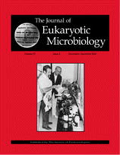
JOURNAL OF EUKARYOTIC MICROBIOLOGY
Scope & Guideline
Fostering Insights into Eukaryotic Microbial Ecology
Introduction
Aims and Scopes
- Taxonomy and Phylogenetics of Eukaryotic Microorganisms:
The journal emphasizes the classification and evolutionary relationships of eukaryotic microorganisms, particularly focusing on protists, fungi, and parasites. This includes both traditional morphological studies and modern molecular techniques. - Ecological Interactions and Environmental Adaptations:
Research published in the journal often explores the ecological roles of eukaryotic microorganisms, including their interactions with other organisms and their adaptations to various environmental conditions. - Molecular Biology and Genomics of Eukaryotic Microbes:
The journal provides insights into the molecular mechanisms underlying the biology of eukaryotic microorganisms, including studies on genomics, gene expression, and cellular processes. - Pathogenesis and Host-Pathogen Interactions:
A significant focus of the journal is on understanding the pathogenic mechanisms employed by eukaryotic parasites and their interactions with host organisms, which is crucial for developing therapeutic strategies. - Novel Discoveries and Taxonomic Revisions:
The journal frequently publishes studies that describe new species, genera, and families, as well as revisions of existing classifications based on new morphological and genetic data.
Trending and Emerging
- Microsporidia and Their Pathogenic Mechanisms:
Recent publications have shown a significant rise in research on microsporidia, particularly regarding their unique biology, pathogenic mechanisms, and interactions with hosts, indicating a growing recognition of their impact on health and ecology. - Molecular Phylogenetics and Genomics:
There is an increasing trend in the use of molecular phylogenetics and genomics to unravel the evolutionary relationships among eukaryotic microorganisms. This includes advances in high-throughput sequencing technologies that enable detailed genetic studies. - Ecological and Environmental Impacts of Eukaryotic Microbes:
Emerging themes focus on the ecological roles and environmental impacts of eukaryotic microorganisms, particularly in relation to climate change and ecosystem health, reflecting a broader ecological perspective in microbiology. - Host-Microbe Interactions and Immunology:
A growing number of studies are exploring the complex interactions between eukaryotic microbes and their hosts, including immune responses and the implications for disease, highlighting the importance of understanding these relationships in health contexts. - Biodiversity and Conservation of Eukaryotic Microorganisms:
Research addressing the biodiversity of eukaryotic microorganisms and their conservation in changing environments is gaining traction, as scientists increasingly recognize the importance of these organisms in global biodiversity and ecosystem services.
Declining or Waning
- General Ecology of Eukaryotic Microbes:
There has been a noticeable decline in publications focusing broadly on the ecology of eukaryotic microorganisms without specific context or application, possibly as research becomes more specialized and targeted. - Morphological Studies Without Molecular Data:
Research that relies solely on traditional morphological approaches, without accompanying molecular analyses, has decreased, as the field increasingly values integrative approaches that combine both morphological and molecular data. - Studies on Non-pathogenic Eukaryotic Microbes:
Research focusing on non-pathogenic eukaryotic microorganisms, such as beneficial protists or those in symbiotic relationships, appears to be less frequently published, potentially overshadowed by the more pressing concerns of pathogenic organisms.
Similar Journals
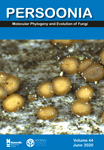
PERSOONIA
Connecting Scholars through High-Impact ResearchPERSOONIA, a distinguished journal published by RIJKSHERBARIUM, serves as a pivotal platform for the dissemination of high-quality research in the fields of Ecology, Evolution, Behavior, and Systematics, as well as Plant Science. Established with a commitment to advancing scientific knowledge, PERSOONIA has achieved an impressive Q1 ranking in these areas, highlighting its significant impact within the academic community, as evidenced by its ranking of #12 out of 721 journals in its field, placing it in the top 2% of publications. With a publication history that spans from 1996 to present, the journal regularly features innovative studies that push the boundaries of understanding in ecological and botanical sciences. While Open Access options are currently limited, researchers and professionals alike benefit from subscription access to this vital resource. Located in the Netherlands, PERSOONIA continues to be a beacon for scholars aiming to enrich the discourse in evolving ecological and plant science disciplines.

Jundishapur Journal of Microbiology
Championing the evolution of microbiological research since 2009.Welcome to the Jundishapur Journal of Microbiology, a peer-reviewed publication dedicated to advancing the field of microbiology. Published by BRIEFLAND, this journal focuses on key areas such as infectious diseases and medical microbiology, offering a platform for researchers to share their findings from 2009 to 2024. Despite its current positioning in Quartile 4 across various categories in 2023, the journal provides a valuable resource for budding scientists and established professionals alike, contributing to the growing body of knowledge in these critical areas. While it is not an open-access journal, the Jundishapur Journal prioritizes the dissemination of research in the Netherlands, facilitating a deeper understanding of microbial science and its implications for public health. Join a community of innovators committed to exploring both emerging and established themes in microbiology.

TAIWANIA
Cultivating collaboration to address crucial ecological challenges.TAIWANIA is a prestigious and long-standing journal dedicated to the fields of ecology, evolution, and systematics, published by NATIONAL TAIWAN UNIVERSITY PRESS. Since its inception in 1947, this open-access journal has provided a vital platform for researchers to disseminate their findings, encouraging collaboration and innovation in the ecological sciences. With a 2023 impact factor placing it in Quartile 2 for Ecology and Quartile 3 for Ecology, Evolution, Behavior and Systematics, TAIWANIA is recognized for its quality and influence, ranking #267 out of 461 in Environmental Science and #426 out of 721 in Agricultural and Biological Sciences within Scopus. The journal currently publishes contributions from both local and international researchers, showcasing a diverse array of topics that address crucial ecological issues and facilitate the advancement of knowledge in the discipline. For those seeking rigorous research, engaging reviews, and a commitment to open access, TAIWANIA remains a significant resource for the global scientific community.
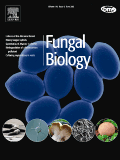
Fungal Biology
Advancing Mycology Through Innovative ResearchFungal Biology, published by Elsevier Science Ltd, is a premier journal dedicated to advancing the field of mycology and its interdisciplinary applications. With an ISSN of 1878-6146 and E-ISSN 1878-6162, this journal serves as a vital platform for researchers and professionals interested in the ecological, evolutionary, and genetic aspects of fungi, as well as their implications in infectious diseases and plant sciences. As of 2023, it proudly holds a Q2 ranking in Ecology, Evolution, Behavior and Systematics and Plant Science, and a Q3 ranking in Genetics and Infectious Diseases, highlighting its significant contribution to these domains. The journal boasts an impressive Scopus rank, including a percentile of 83rd in Ecological studies, ensuring that published research reaches a wide audience and impacts ongoing discourse in the field. With open access options, Fungal Biology encourages the dissemination of high-quality research, aimed to foster collaboration and innovation among scholars and practitioners. With its convergence of knowledge from 2010 to 2024, this journal is instrumental for those advancing the understanding of fungal biology and its myriad applications in environmental and health sciences.
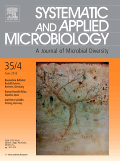
SYSTEMATIC AND APPLIED MICROBIOLOGY
Pioneering Research in Ecology and BiotechnologySYSTEMATIC AND APPLIED MICROBIOLOGY, with ISSN 0723-2020 and E-ISSN 1618-0984, is a prestigious journal published by Elsevier GmbH, located in Munich, Germany. Established in 1983, this journal provides a critical platform for the dissemination of high-quality research in the fields of applied microbiology, ecology, and biotechnology. With a commendable impact reflected in its 2023 Q1 ranking in Applied Microbiology and Biotechnology, and Ecology, Evolution, Behavior and Systematics, along with a Q2 ranking in Microbiology, SYSTEMATIC AND APPLIED MICROBIOLOGY maintains a high standard of scholarly excellence. As part of the Scopus database, it ranks prominently—79th out of 721 in Ecology, and within the top quartiles for its relevant fields, potent in disseminating implications for researchers, professionals, and students alike. Although it does not offer open access, the journal is dedicated to advancing knowledge and innovation in microbiological research, making it an essential resource for anyone in the field seeking to stay abreast of current findings and applications.

Journal of Fungi
Cultivating Knowledge in Fungal SciencesJournal of Fungi is a premier open-access journal published by MDPI, dedicated to advancing the understanding of fungal biology in its myriad forms. Since its inception in 2015, it has become a vital resource in the fields of ecology, evolution, and plant sciences, attaining notable rankings in Scopus, including Q1 status in Ecology, Evolution, Behavior and Systematics, and Plant Science, with a Q2 ranking in Microbiology (medical). The journal fosters a collaborative platform for researchers, professionals, and students by providing unrestricted access to high-quality, peer-reviewed articles, which encourages the dissemination of innovative findings and methodologies relevant to fungal research. Designed to cater to a global audience, the Journal of Fungi has established its significance in the scientific community, especially from its base in Switzerland, where it continues to contribute to the ongoing discourse in mycology and beyond. With its commitment to open access since its launch and its continuous support for groundbreaking research, the journal plays a crucial role in driving forward the scientific inquiry and ecological awareness in fungal studies.

mSphere
Unleashing the power of molecular exploration.mSphere is a leading open-access journal published by the American Society for Microbiology, dedicated to the dynamic fields of Microbiology and Molecular Biology. Since its inception in 2016, mSphere has rapidly established itself as a reputable source of scholarly research, achieving notable impact factors and excellence within the academic community. The journal ranks in the top quartile (Q1) amongst its peers in Microbiology, and Q2 in the field of Molecular Biology, demonstrating its significance and relevance through Scopus rankings—specifically, it holds the #42 spot out of 182 in the Microbiology category and #108 out of 410 in Molecular Biology. With an editorial commitment to advancing the understanding of microbial and molecular sciences, mSphere provides an accessible platform for researchers, professionals, and students alike to disseminate groundbreaking findings. The journal promotes rigorous peer-review and invites innovative contributions aimed at enhancing microbial research mobility and molecular exploration. Accessible openly since 2016, mSphere continues to thrive as an influential publication driving scientific dialogue and discovery in the microbiological sciences.
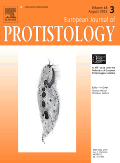
EUROPEAN JOURNAL OF PROTISTOLOGY
Championing High-Quality Protist ResearchThe EUROPEAN JOURNAL OF PROTISTOLOGY, published by Elsevier GmbH, serves as a premier platform for disseminating high-quality research in the field of microbiology, particularly focusing on protistology. With its ISSN 0932-4739 and E-ISSN 1618-0429, this journal has been an essential resource for academics and professionals since its inception in 1987, continuing to impact the scientific community through to 2024. Ranked in the 2023 Q3 category for microbiology, it occupies a significant position in the Scopus rankings, specifically within the disciplines of Immunology and Microbiology, emphasizing its relevance amid a competitive landscape. The journal's commitment to advancing our understanding of protists fosters innovation and contributes to critical discourse among researchers and students alike. Although it does not currently offer open-access options, its rigorous peer-review process ensures that all published work maintains the highest standards of scientific integrity and relevance, making it an indispensable reference for those engaged in microbiological research.

ANTONIE VAN LEEUWENHOEK INTERNATIONAL JOURNAL OF GENERAL AND MOLECULAR MICROBIOLOGY
Connecting Researchers to the Heart of Microbial StudiesANTONIE VAN LEEUWENHOEK INTERNATIONAL JOURNAL OF GENERAL AND MOLECULAR MICROBIOLOGY, published by Springer, is a vital resource for advancing research in the fields of microbiology and molecular biology. With its ISSN 0003-6072 and E-ISSN 1572-9699, this journal consistently focuses on cutting-edge studies and developments, providing a platform for the dissemination of knowledge that spans over its rich history from 1934 onwards. The journal holds an impressive reputation, ranked Q2 in Medicine (miscellaneous) and Q3 in both Microbiology and Molecular Biology for 2023, reflecting its significant contribution to the scientific community. Researchers and professionals from various disciplines rely on this journal for quality publications that address complex microbial interactions and molecular mechanisms. Although it currently does not provide open access options, its compelling research remains accessible through institutional subscriptions, allowing it to foster collaborative advancements in the ever-evolving landscape of microbiological sciences.

FUNGAL GENETICS AND BIOLOGY
Shaping the Future of Fungal ResearchFungal Genetics and Biology is a leading peer-reviewed journal published by Academic Press Inc, Elsevier Science, dedicated to advancing the understanding of fungi through innovative genetic and biological research. Since its inception in 1996, this journal has served as a vital platform for the dissemination of critical findings in the fields of Genetics and Microbiology, maintaining a distinguished Q2 category ranking in both disciplines as of 2023. With an ISSN of 1087-1845 and an E-ISSN of 1096-0937, the journal emphasizes the intersection of genetics and molecular biology to explore fundamental questions related to fungal biology that are of paramount importance to various applications in biotechnology, medicine, and environmental science. Researchers, professionals, and students alike will find this journal invaluable as it not only covers current trends and breakthroughs but also encourages collaborative efforts across the scientific community. Fungal Genetics and Biology continues to shape the future of fungal research well into 2024 and beyond, offering rich insights and open access options for a global audience.